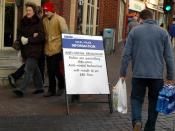Introduction:
Since as early as the 18th Century, there have been many theories as to the possible causes of juvenile crime. Scientific, biological, environmental and economical factors have all been put forward as singular explanations. Modern theorists however feel that one single factor is not likely to be the only answer. Most favour "multiple" factors. Multiple factors is a combination of influences that come into play together throughout the childhood of juveniles and this seems to be the most plausible explanation.
The influences that make up the "multiple" factors theory are thought to be combinations of biological, psychological, cultural, economic and political.
Below, I will discuss some of these influences that, when present in a child's life, can increase the chances of a child committing a crime.
Theories:
Family Factors:
Children learn from their family. They learn right from wrong from the family around them. Parents and siblings that behave in an unacceptable manner lead to the child believing that this is "normal" behaviour.
Research has shown that "children who have anti-social or violent parents are more likely to be anti-social or violent themselves" (p673) 1.
Poor parental supervision often means that they do not know where or what their child is doing. They often find out about a child's involvement in anti-social or criminal behaviour via other people.
Adding to this, parents that show little or no interest do not reprimand bad behaviour. This lack of discipline means a child does not relate their behaviour with any adverse consequences, and so has no fear of what the outcome of their bad behaviour will be.
It has, however, been shown that harsh punishment is a predictor in future convictions. "40% of offenders had been smacked or beaten at age 11" John and Elizabeth Newson (1989, cited by Farrington)2
Another indicator that a child may commit a crime is living in a family that already has an offender within it. Studies have shown that "having a convicted father, mother, brother or sister predicts a boys own convictions" Farrington et.al (1996, cited by Farrington) 3
Child abuse: Child abuse is a very disturbing fact in our communities. Children suffering this kind of torment in their lives can feel very confused, lonely and frightened, often feeling they have no one to turn to.
The effects that abuse can have on the child do include later anti-social and/or criminal behaviour.
Abused children tend to leave home, and the situation, as soon as they can. This can lead to them ending up homeless. They may then turn to crime as a way of getting money and, in the case of girls, turn to prostitution. This seems especially true of sexually abused children (p204)4
A study by McCord(1983, cited by Farrington)5 found that "about half of boys that had been abused or neglected were convicted of serious crimes became alcoholics, mentally Ill or died before age 35".
It has also been suggested that abuse can foster feelings of anger and frustration leading to aggressive behaviour by the child. They may also copy the abusive behaviour that has been bestowed upon them and use it on their own peers or siblings, not understanding that it is unacceptable behaviour in society, or simply to gain some kind of feeling of revenge for what they have suffered.
Large Family Size: Children living in a large family, generally with more than 4 siblings are at higher risk of becoming delinquent. This may be because parent's individual attention is harder for the child to get with siblings wanting this same individual attention.
Money can be an issue in larger families and may be tighter. Children can feel jealous because their friends have items that their family cannot afford. This may lead to stealing as a way of gaining items a child wants.
Issues can also arise from the feelings of lack of privacy and the inability to "get away" from siblings for some quiet time alone or studying. Especially as younger siblings can be noisy and boisterous and not understanding the need of the older child for privacy.
This can be exacerbated because the parents find it harder to supervise so many children at one time and discipline may be overlooked on occasion. So the child may feel angry and let down by their parents, which could lead to fighting within the sibling group.
Friends:
The friends that a child is exposed to are likely to be a big influence outside of the family. When juveniles get together, they can often be goading each other into committing criminal offences, they do it to 'make them look big'. Studies have shown that "68% of youths committed offences with someone else" (p27)6
Friends can also make things seem so much more fun and a laugh. "39% of youths commit crime for fun" (p27)7
A further "23% committed crimes because of boredom" (p29)8 . Juveniles hanging around are often being moved on from one area to another. This leads to frustration and resentment, thus leading to crimes being committed.
Alcohol:
Alcohol consumption is popular with juveniles, especially lager and beer. Most juveniles seem to have little problem getting hold of alcohol and are regularly able to buy it from pubs, clubs and stores.
Drinking alcohol lessens inhibitions and raises confidence, which can embolden juveniles to commit a crime. "15% of 12-17 year olds studied said that they have been involved in anti-social behaviour during or after drinking alcohol" (p3)9.
School:
It has been shown that children who do not perform well at school are more likely to commit crime and the feelings of failure and inadequacy, rather than the actual lack of intelligence also contribute to the risk.
Bullying at school indicates an increased risk of offending. "Bullies usually have aggressive personalities and are also below average achievers" Olweus(1984 cited in Youth Justice Board Risk and Protective Factors). Juvelines that bully are more likely to be bullies in their adulthood, and this, in turn, could mean that their children becoming bullies at school.
Truancy is also a big problem in schools. The consequence of truancy means a lack of the school's positive influence on the juveniles who play truant. This can be a reason why some end up involved in crime and anti-social behaviour. It should be noted that Graham (1988) expressed that "While truancy can lead to delinquency it is likely that delinquency leads to truancy as well" (cited in Youth Justice Board risk and protective factors).
Community:
The risk of a juvenile committing a crime appears to increase when that child is raised in a community that is deprived with poor living conditions and high rates of unemployment. It goes hand in hand with other risk factors such as low income and is difficult to prove as a significant factor alone.
Run down and neglected communities are often riddled with graffiti and are not looked after by the landlord. There tends to be little for juveniles to do and organised activities are not usually available. This can lead to boredom that, in turn, can lead to anti-social behaviour, alcohol consumption and even drug taking, which appear to be in wider use in this type of community that makes it easier to obtain.
However, studies have shown that moving juvenile boys out of a deprived community and placing them into a more affluent area significantly reduced the risk of them committing crime (p18)10
Tv and media:
Violence, murder and even rape are shown much more readily and in some cases, in much more detail these days. Although films are given an age rating on Videos and DVD's and are broadcast after the "watershed" on television. There are still occasions when children are watching films not recommended for their age group, especially 18 certificate.
This may be because friends parents are more "easy going" about what their children watch and let them and their friends watch inappropriate films or the child's own parents just don't care what they watch, the latter being happy that the child is "out of the way" and being quiet thus enabling the parents to get on with whatever they want to do without fuss or interruption.
Juveniles may want to copy what they seen in films, and Morrison(1997) reports the allegation that "the murderers of Jamie Bulger had been influenced by the video Child's Play 3 in the manner in which they killed the unfortunate toddler" (cited in The Oxford Handbook of Criminology p395).
Conclusion:
It has been shown that there are many influences in a child's life, but I think family is the most important factor for any child as they grow up. A stable, loving, respectful and guiding family can be all that a child needs to guide it through a crime free life, no matter where they live, how much money the family has, or how many crime opportunities arise. If the family they live in teaches them good values and right from wrong in a consistent and loving way, the child can make an informed choice and understand that crime is not the right option.
References used:
1 Oxford Handbook of Criminology 3rd Edition - Farrington
2 p. 673 - Oxford Handbook of Criminology 3rd Edition - Farrington
3 p.670 - Oxford Handbook of Criminology 3rd Edition - Farrington
4 Crime and Society in Britain - Hazel Croall
5 p674 - Oxford Handbook of Criminology 3rd Edition
6 MORI Youth Survey 2004 - MORI - Youth Justice Board
7 MORI Youth Survey 2004 - MORI - Youth Justice Board
8 MORI Youth Survey 2004 - MORI - Youth Justice Board
9 Underage Drinking - Findings from the 1998-99 Youth Lifestyle Survey - Victoria Harrington
10 Risk and Protective Factors 2005 - Youth Justice Board


